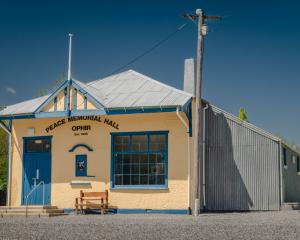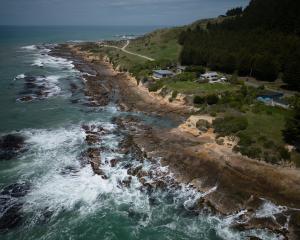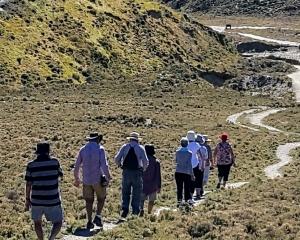A skeleton of a fin whale has been hanging from specially designed and built iron girders in the Otago Museum since 1883.
In The Lives of Colonial Objects, even the seemingly ordinary can offer exceptional insights into New Zealand's cultural fabric. The following extract from the book traces the tale of a whale (skeleton).
It has not moved from its original position - all dusting, cleaning and other maintenance has been carried out in situ - while other zoological specimens have moved between displays to laboratories and storage rooms.
During a major refurbishment in 1973 the original three floors of the museum were floorboarded in and the whale became the centrepiece of a permanent maritime-themed gallery.
The implied connections between the whale, and whaling, and the 50 model ships, flags and ship's bells that now surround it are left to the visitor to interpret.
Contextual meanings of the skeleton may have changed since its installation but the bones themselves have remained static. This symbol of colonial interest in the natural world helps us to understand the importance of science carried out for its own sake, compared with earlier commercial exploitation of whales.
When zoology was the dominant science in the late 19th century each museum wanted its own drawcard. Large specimens fitted the bill and in New Zealand whales were an obvious choice. Complete skeletons were relatively rare; skulls, teeth and bones were more commonly preserved.
By 1883 Otago, Wellington and Canterbury museums had skeletons but none matched the huge 27-
metre skeleton of a black right whale which, because of its size, was mounted outside the National Museum at the University of Melbourne from 1867.
In 1877 the Otago Museum opened in a newly built neo-classical building and the first sight that greeted visitors was a ‘‘skeleton of a huge whale, and in close proximity the skeletons of moas and other large struthious [ostrich-like] birds, and the skeleton of a giraffe''.
Five years later, in 1882, the Dunedin correspondent for the Tuapeka Times noted that there had been many improvements but that the museum curator, Professor T. Jeffery Parker, had a ‘‘mania for skeletons ... [and] has procured some splendid and interesting specimens of birds and fish''.
It was a natural instinct for Parker, a renowned zoologist, to indulge his obsession so when the opportunity arose to acquire a second whale in 1883 he did not hesitate - it was the ultimate icon of civic pride and science.
Parker acquired his fin whale from Captain William Jackson Barry, a noted ‘‘colonial character'' who brought the skeleton to Dunedin on a cart in 1883 having purchased the remains of a whale that had beached itself in the Nelson area that year.
After having it defleshed and the bones cleaned, he exhibited the skeleton at a store in Nelson before carting it off, on show, to various towns, ending up in Dunedin.
By June 1883 he had set up the whale at a warehouse in St Andrew Street, where he set to work joining its bones together before opening it up to public inspection, including hosting a dinner party for ‘‘a number of ladies and gentlemen ... in the jaws of the monster whale''.
It remained on display during June and July, attracting ‘‘a considerable number of people, who all expressed astonishment at the dimensions''.
But by the middle of August a one-sentence newspaper report recorded that ‘‘Captain Barry has disposed of his whale skeleton to the Otago Museum'' And so Captain Barry's whale became Professor Parker's whale.
When Parker read a paper to the Otago Institute in October 1883 on the skeleton of a whale then being mounted in the museum, he gave the creature a new life by turning it into a sober means of edification rather than a prop valued for its entertainment appeal alone.
The man who endowed the whale with such gravitas was Thomas Jeffery Parker (1850-1897), the first professor of biology at the University of Otago, a position he held concurrently with that of curator of the Otago University Museum.
He arrived in Dunedin in 1880 from London where he had spent eight years teaching in the biological laboratory of Thomas Henry Huxley (1825-1895). Best known as ‘‘Darwin's Bulldog'', Huxley was a scientific educator and canvasser for a growing corps of younger men, like Parker, who made their living from scientific work.
Parker was clearly impressed with his new acquisition. He told his Christchurch-based friend and counterpart, Julius von Haast (1822-1887), that it was in ‘‘very good condition except that a portion of caudal vertebrae were thrown away with the flukes and many of the phalanges are lost ...
The baleen is in beautiful condition, & the skeleton altogether will be a very fine one. It is to be slung from iron girders supported by the columns. What size is your specimen? Mine is 54ft 6ins''.
Measurement was an important observational and empirical methodology in Victorian zoology. As historian Lorraine Daston has explained, it was part of the collective nature of scientific endeavour.
Like other scientific workers, Parker established a persona of disinterested objective observer with the paper he wrote for the Transactions and Proceedings of the New Zealand Institute, recording that the bones were only ‘‘roughly set up'': ‘‘Captain Barry ... unfortunately was not sufficiently aware of the value of a complete whale's skeleton to give the proper amount of care to the smaller bones.
The eight posterior caudal vertebrae were thrown away with the flukes; the anterior epiphysis of the fifth cervical vertebra is missing; many of the phalanges and some of the carpals are lost and no trace of either pelvic bone reached Dunedin''.
The paper is full of close and careful observations written in what H.G. Wells, one of Huxley's biology students, called the ‘‘dialect of science''. By this means the hanging whale in the museum became a purveyor of knowledge, which was a world away from hosting a dinner party in its jaws.
And yet Parker's published account hides his anxieties and angst. In a letter to William Henry Flower (1831-1899), the director of the Natural History Museum in London, he wrote: ‘‘I send with this a photograph of the Museum showing a skeleton of Balaenoptera I had put up some time ago. I feel a little uncomfortable about the (artificial) pelvic bones, which are modelled from a figure of Haast's. Ought they to be reversed?''
Flower had a specialist interest in cetaceans and about a quarter of his published work was on the group.
Parker compared his whale carefully with Flower's accounts and despite differences in the sternum, which Parker thought could be due to individual variation, came to the conclusion that it was a young specimen of a blue whale.
But he agreed with Flower that more research on whales, particularly living ones, was needed to establish the links between northern and southern hemisphere species.
The members of the public who came to see Professor Parker's whale almost certainly included some of those who had gone to see Captain Barry's.
But Parker's main target was his students, both those studying zoology and those doing medicine, for whom a course in comparative animal anatomy was compulsory: access to the bones served the purpose better than stuffed specimens.
Even if the whole whale carcass had been available to make a taxidermic specimen, it would have proved particularly difficult. Whale skin could not be preserved like other mammalian skins.
As Parker phrased it, ‘‘the blubber passed insensibly into the cuticle'', which made it ‘‘so delicate as to be torn with the slightest traction'', and in the words of one American taxidermist, the ‘‘remarkably thin and fragile'' skin tended ‘‘to discolour and decay quickly upon its owner's death''.
During the 1870s and 1880s there was much debate about the purpose of museums. Huxley suggested the primary objective was ‘‘the public exhibition of a collection of specimens large enough to illustrate all the most important truths of natural history'' and that only the serious student should have access to separate study collections.
In his ideal museum, curators and students could move about behind the public displays, sharing space with drawers and cabinets full of specimens, separated from visitors.
The secondary benefits of such arrangements included conservation, the exclusion of dust and dirt and the provision of workrooms. This, historian Samuel Alberti points out, was part of Huxley's desire to construct a ‘‘privileged space for the expert''.
Part of the museum discussion concerned the maintenance of order, presenting items properly so they would not degenerate into a higgledy-piggledy jumble of curios.
In the presidential address to the Newcastle meeting of the British Association for the Advancement of Science in 1889, Flower issued some instructions on how best to display specimens.
Importantly, ‘‘every specimen must be good of its kind ... none must be placed too high or too low for ready examination. There must be no crowding of specimens one behind the other, every one being perfectly and distinctly seen, with a clear space around it''.
Parker had limited ability to separate study collections from those on display, and little physical room to follow Flower's advice on overcrowding.
This explains why his whale could only be hung from the girders, since the floor space was still taken up with the original whale, moa and giraffe skeletons. Parker's avowed evolutionary principles guided his work.
Evolution dictated which specimens he should acquire and how he should display the collections. After all, ‘‘organizing and displaying is a way of visualizing the invisible, of making ideas palpable''.
Surprisingly Darwin's On the Origin of Species, published in 1859, took several decades to permeate and affect the display ethos of museums.
Parker's scheme was, by his own admission, tentative. There was no fixed methodology by which to group specimens, or the order that they should fit. The audience relied on supporting textual information to make sense of the displays.
Parker had to battle against both an inconveniently arranged building and a lack of space.
‘‘It is practically impossible,'' he wrote, ‘‘to arrange the doors, passages, galleries, etc, [so] that the visitor is obliged to traverse them in a certain direction, and so to have forced upon him the natural sequence.''
By this Parker meant a narrative of evolutionary progression through the animal kingdom.
He did the best he could, but bemoaned the fact that the birds had to be accommodated in wall-cases on the upper gallery, mammals in the lower gallery, with smaller invertebrates ‘‘exhibited in flat cases or desks, which could only be conveniently placed round two galleries and between the windows in the lower gallery, in places where wall-cases were inadmissible''.
This, he claimed, made the natural sequence unclear to an ordinary observer. In its life-after-death the whale proved by turns a source of entertainment, edification and education.
The unchanging exhibition of one skeleton has emphasised the changing shifts in focus and fashion, although its current location among ships and maritime artefacts is rather different from that intended by Parker, the evolutionist.
Footnote: Management of the Otago Museum passed to the University of Otago in 1877. This arrangement lasted until 1955 when a new governance structure was established by the passing of the Otago Museum Trust Board Act.












